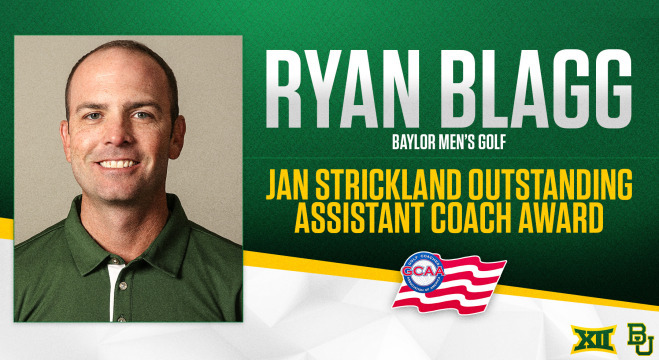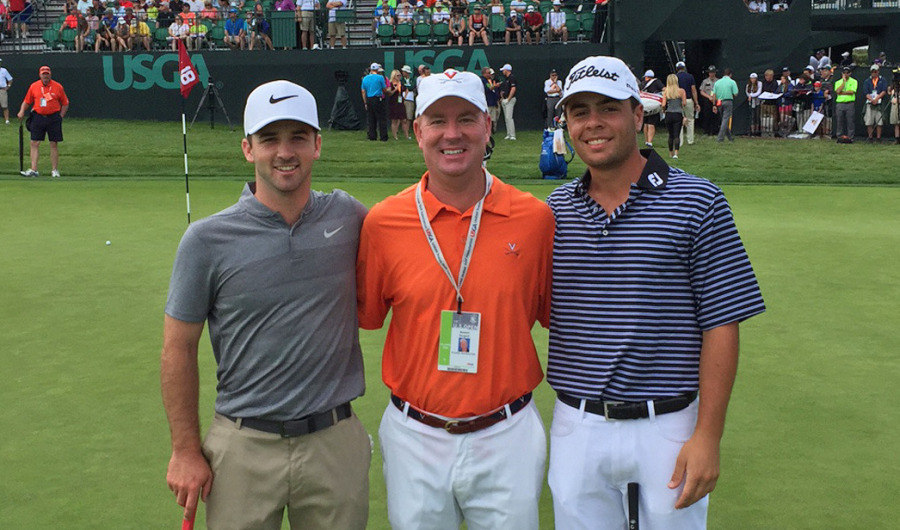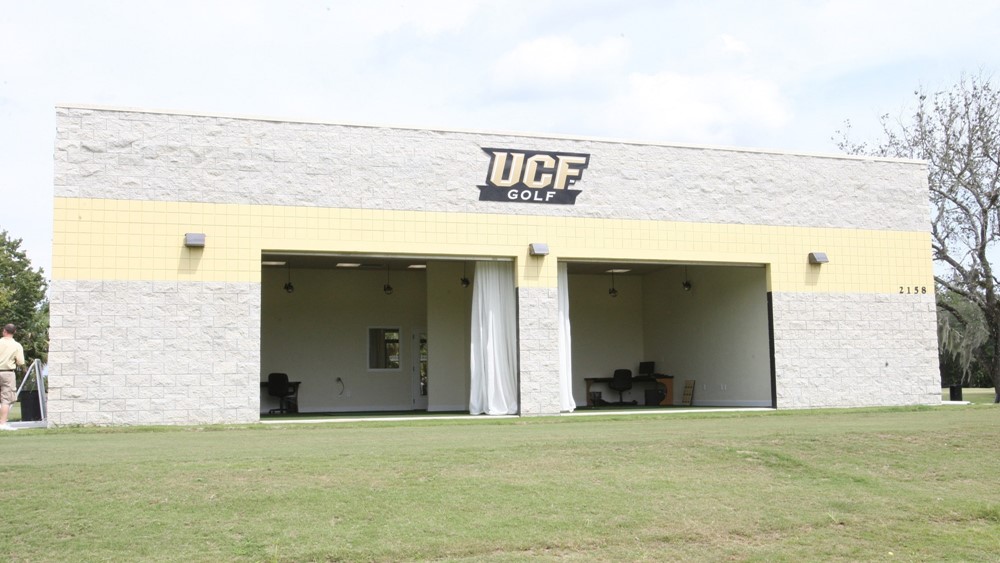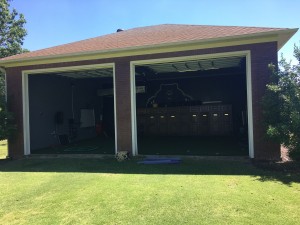Opinion & Analysis
10 Years Later: Why the assistant coach has made college golf better

It’s been 10 years since the NCCA Legislation began allowing assistant golf coaches to perform on-course coaching in college events. Today, 94 percent of the top-100 men’s golf teams have assistant coaches, and the coaching pool is stronger than ever, with individuals such as Jean Paul Hebert (Texas), Jake Amos (South Carolina), Ryan Jamieson (Florida), Robert Duck (Florida State), Donnie Darr (Oklahoma State), John Mills (Kent State), Garrett Runion (LSU), Zach Barlow (Illinois), Bob Heinz (Duke), and 2017 Assistant Coach of the Year from Baylor, Ryan Blagg. The list includes a guy with 20+ PGA Tour experience (Bob Heinz), several former college standouts and some National Championship wins (Jean Paul Hebert – 1, Runion – 2, Amos – 2).

In the 10 years since the expanded role of the assistant golf coach, the National Championship has still been dominated by major conference schools, with only three non-major conference schools earning a spot in match play (Kent State 2012, and Augusta State in 2010, 2011). Of course, Augusta State went on to win both of its appearances in match play, earning back-to-back national championships under Coach Josh Gregory.
One of best examples of the success of assistant golf coaches is Chris Malloy at Ole Miss. Malloy, a graduate of Ole Miss, began his coaching career as the women’s assistant golf coach at Florida State. Shortly after, he was working with both programs and had an immediate impact, which included helping the men win their first ever ACC championship. Shortly after, Chris took over as the men’s golf coach at University of South Florida, transforming the team into a National Contender and a top-30 ranking. Today, at Ole Miss, Chris has done the same thing, transforming a team and a culture in three years, earning a spot in the 2017 NCAA National Championship at Rich Harvest Farms.
Another great example is Sooner coach Ryan Hybl, who in 2017 lead his team to the NCAA National Championship. Hybl, an outstanding player at Georgia, then was an assistant with the program from 2005-2009. The system continues to work as three notable assistants made moves this summer; Jim Garden from OU to Coastal Carolina, John Handrigan from UF to Notre Dame and Dusty Smith from Vanderbilt to Mississippi State.
Although to date, mid-major teams have not fared consistently on the national level. The system of assistant coaches has proven to be an excellent tool in broadening the pool of candidates. Last year’s National Championship featured six mid-major schools with half being wily veterans, and half being a product of the assistant coach route; Michael Beard of Pepperdine served as the assistant at Arizona State; Bryce Waller of University of Central Florida served as the assistant at the University of Tennessee; Bryant Odem of Kennesaw State served as the assistant at the University of Wisconsin. It will also feature teams like Oklahoma State, Baylor, Virginia, Oklahoma, Vanderbilt, Ole Miss and Purdue, which have coaches who have benefited from their experience as assistant coaches in their roles with these programs.
The pool of candidates for coaching positions today is deeper than ever. Athletic Directors are blessed to be able to interview several good candidates for almost each job. The result for the players are fully engaged coaches who bring passion and desire to improve each of their programs.
Bowen Sargent, the current head coach at University of Virginia and former assistant coach at the University of Tennessee under Jim Kelson, started coaching when the rules only allowed one coach. In the 10 years since the rule change, Bowen believes “it’s a positive change for sure. Having two coaches allows for a better student-athlete experience and for them to have more access to their coaches.”

Coach Bowen Sargent of UVA, along with former players Denny McCarthy and Derek Bard at the U.S. Open
The diversity among coaches is also greater. Today’s juniors have the option to play for a skillful player such as a Mike Small at Illinois or Casey Martin at Oregon, or Doug Martin at Cincinnati, or even a world class instructor like Bryce Waller at UCF, Ben Pellicani at Limpscomb or Casey Van Dame at South Dakota State. Waller, an excellent instructor himself, has lead UCF to three National Championship appearance in 7 years. Likewise, Ben, a Golf Digest top-40 under-40 instructor who spent several years learning from Mike Bender has been instrumental in transforming Limpscomb into a national contender, participating in their first ever National Championship in 2017. Lastly, Casey who spent several years under Jim Mclean, then as the assistant at University of Tennessee, has transformed South Dakota State Men’s and Women’s Golf, with both teams currently ranked in the top-100 in the country.
Athletic Directors are also starting to put more funding towards golf resources. The result has been an explosion of golf-specific training facilities across the scope of college golf. Many mid-major schools have top-notch practice facilities, including places such as University of North Texas, University of Richmond, University of Central Arkansas and Illinois State to name a few.
The tremendous pool of coaching candidates has also benefited other levels of golf. For example, 2014 Assistant Coach of the Year Chris Hill is now the head men’s and women’s golf coach at Concordia University, a Division 3 School near Austin, Texas. In his two years as coach, he has already lead the program to seven tournament titles.
As time passed, I believe that we will see a change at the NCAA Championship and it will include a growing trend towards mid-major universities not only earning spots at the National Championships, but having success like Augusta State. The person at the head of one of those programs is likely to have come from the assistant coach ranks and should be thankful for the rule change, which lead to these opportunities.
Please note: As of writing this article, only 6 men’s teams in D1 do not have assistant coaches. They are UTEP (51), McNeese (84), Nevada (88), Richmond (89), Cincinnati (92) and Tennessee at Chattanooga (96).
- LIKE28
- LEGIT6
- WOW1
- LOL0
- IDHT1
- FLOP0
- OB0
- SHANK2
19th Hole
Vincenzi’s 2024 Zurich Classic of New Orleans betting preview

The PGA TOUR heads to New Orleans to play the 2023 Zurich Classic of New Orleans. In a welcome change from the usual stroke play, the Zurich Classic is a team event. On Thursday and Saturday, the teams play best ball, and on Friday and Sunday the teams play alternate shot.
TPC Louisiana is a par 72 that measures 7,425 yards. The course features some short par 4s and plenty of water and bunkers, which makes for a lot of exciting risk/reward scenarios for competitors. Pete Dye designed the course in 2004 specifically for the Zurich Classic, although the event didn’t make its debut until 2007 because of Hurricane Katrina.
Coming off of the Masters and a signature event in consecutive weeks, the field this week is a step down, and understandably so. Many of the world’s top players will be using this time to rest after a busy stretch.
However, there are some interesting teams this season with some stars making surprise appearances in the team event. Some notable teams include Patrick Cantlay and Xander Schauffele, Rory McIlroy and Shane Lowry, Collin Morikawa and Kurt Kitayama, Will Zalatoris and Sahith Theegala as well as a few Canadian teams, Nick Taylor and Adam Hadwin and Taylor Pendrith and Corey Conners.
Past Winners at TPC Louisiana
- 2023: Riley/Hardy (-30)
- 2022: Cantlay/Schauffele (-29)
- 2021: Leishman/Smith (-20)
- 2019: Palmer/Rahm (-26)
- 2018: Horschel/Piercy (-22)
- 2017: Blixt/Smith (-27)
2024 Zurich Classic of New Orleans Picks
Tom Hoge/Maverick McNealy +2500 (DraftKings)
Tom Hoge is coming off of a solid T18 finish at the RBC Heritage and finished T13 at last year’s Zurich Classic alongside Harris English.
This season, Hoge is having one of his best years on Tour in terms of Strokes Gained: Approach. In his last 24 rounds, the only player to top him on the category is Scottie Scheffler. Hoge has been solid on Pete Dye designs, ranking 28th in the field over his past 36 rounds.
McNealy is also having a solid season. He’s finished T6 at the Waste Management Phoenix Open and T9 at the PLAYERS Championship. He recently started working with world renowned swing coach, Butch Harmon, and its seemingly paid dividends in 2024.
Keith Mitchell/Joel Dahmen +4000 (DraftKings)
Keith Mitchell is having a fantastic season, finishing in the top-20 of five of his past seven starts on Tour. Most recently, Mitchell finished T14 at the Valero Texas Open and gained a whopping 6.0 strokes off the tee. He finished 6th at last year’s Zurich Classic.
Joel Dahmen is having a resurgent year and has been dialed in with his irons. He also has a T11 finish at the PLAYERS Championship at TPC Sawgrass which is another Pete Dye track. With Mitchell’s length and Dahmen’s ability to put it close with his short irons, the Mitchell/Dahmen combination will be dangerous this week.
Taylor Moore/Matt NeSmith +6500 (DraftKings)
Taylor Moore has quickly developed into one of the more consistent players on Tour. He’s finished in the top-20 in three of his past four starts, including a very impressive showing at The Masters, finishing T20. He’s also finished T4 at this event in consecutive seasons alongside Matt NeSmith.
NeSmith isn’t having a great 2024, but has seemed to elevate his game in this format. He finished T26 at Pete Dye’s TPC Sawgrass, which gives the 30-year-old something to build off of. NeSmith is also a great putter on Bermudagrass, which could help elevate Moore’s ball striking prowess.
- LIKE8
- LEGIT3
- WOW1
- LOL1
- IDHT0
- FLOP3
- OB1
- SHANK1
19th Hole
Vincenzi’s 2024 LIV Adelaide betting preview: Cam Smith ready for big week down under

After having four of the top twelve players on the leaderboard at The Masters, LIV Golf is set for their fifth event of the season: LIV Adelaide.
For both LIV fans and golf fans in Australia, LIV Adelaide is one of the most anticipated events of the year. With 35,000 people expected to attend each day of the tournament, the Grange Golf Club will be crawling with fans who are passionate about the sport of golf. The 12th hole, better known as “the watering hole”, is sure to have the rowdiest of the fans cheering after a long day of drinking some Leishman Lager.
The Grange Golf Club is a par-72 that measures 6,946 yards. The course features minimal resistance, as golfers went extremely low last season. In 2023, Talor Gooch shot consecutive rounds of 62 on Thursday and Friday, giving himself a gigantic cushion heading into championship Sunday. Things got tight for a while, but in the end, the Oklahoma State product was able to hold off The Crushers’ Anirban Lahiri for a three-shot victory.
The Four Aces won the team competition with the Range Goats finishing second.
*All Images Courtesy of LIV Golf*
Past Winners at LIV Adelaide
- 2023: Talor Gooch (-19)
Stat Leaders Through LIV Miami
Green in Regulation
- Richard Bland
- Jon Rahm
- Paul Casey
Fairways Hit
- Abraham Ancer
- Graeme McDowell
- Henrik Stenson
Driving Distance
- Bryson DeChambeau
- Joaquin Niemann
- Dean Burmester
Putting
- Cameron Smith
- Louis Oosthuizen
- Matt Jones
2024 LIV Adelaide Picks
Cameron Smith +1400 (DraftKings)
When I pulled up the odds for LIV Adelaide, I was more than a little surprised to see multiple golfers listed ahead of Cameron Smith on the betting board. A few starts ago, Cam finished runner-up at LIV Hong Kong, which is a golf course that absolutely suits his eye. Augusta National in another course that Smith could roll out of bed and finish in the top-ten at, and he did so two weeks ago at The Masters, finishing T6.
At Augusta, he gained strokes on the field on approach, off the tee (slightly), and of course, around the green and putting. Smith able to get in the mix at a major championship despite coming into the week feeling under the weather tells me that his game is once again rounding into form.
The Grange Golf Club is another course that undoubtedly suits the Australian. Smith is obviously incredibly comfortable playing in front of the Aussie faithful and has won three Australian PGA Championship’s. The course is very short and will allow Smith to play conservative off the tee, mitigating his most glaring weakness. With birdies available all over the golf course, there’s a chance the event turns into a putting contest, and there’s no one on the planet I’d rather have in one of those than Cam Smith.

Louis Oosthuizen +2200 (DraftKings)
Louis Oosthuizen has simply been one of the best players on LIV in the 2024 seas0n. The South African has finished in the top-10 on the LIV leaderboard in three of his five starts, with his best coming in Jeddah, where he finished T2. Perhaps more impressively, Oosthuizen finished T7 at LIV Miami, which took place at Doral’s “Blue Monster”, an absolutely massive golf course. Given that Louis is on the shorter side in terms of distance off the tee, his ability to play well in Miami shows how dialed he is with the irons this season.
In addition to the LIV finishes, Oosthuizen won back-to-back starts on the DP World Tour in December at the Alfred Dunhill Championship and the Mauritus Open. He also finished runner-up at the end of February in the International Series Oman. The 41-year-old has been one of the most consistent performers of 2024, regardless of tour.
For the season, Louis ranks 4th on LIV in birdies made, T9 in fairways hit and first in putting. He ranks 32nd in driving distance, but that won’t be an issue at this short course. Last season, he finished T11 at the event, but was in decent position going into the final round but fell back after shooting 70 while the rest of the field went low. This season, Oosthuizen comes into the event in peak form, and the course should be a perfect fit for his smooth swing and hot putter this week.

- LIKE12
- LEGIT3
- WOW1
- LOL1
- IDHT0
- FLOP1
- OB1
- SHANK1
Opinion & Analysis
The Wedge Guy: What really makes a wedge work? Part 1

Of all the clubs in our bags, wedges are almost always the simplest in construction and, therefore, the easiest to analyze what might make one work differently from another if you know what to look for.
Wedges are a lot less mysterious than drivers, of course, as the major brands are working with a lot of “pixie dust” inside these modern marvels. That’s carrying over more to irons now, with so many new models featuring internal multi-material technologies, and almost all of them having a “badge” or insert in the back to allow more complex graphics while hiding the actual distribution of mass.
But when it comes to wedges, most on the market today are still single pieces of molded steel, either cast or forged into that shape. So, if you look closely at where the mass is distributed, it’s pretty clear how that wedge is going to perform.
To start, because of their wider soles, the majority of the mass of almost any wedge is along the bottom third of the clubhead. So, the best wedge shots are always those hit between the 2nd and 5th grooves so that more mass is directly behind that impact. Elite tour professionals practice incessantly to learn to do that consistently, wearing out a spot about the size of a penny right there. If impact moves higher than that, the face is dramatically thinner, so smash factor is compromised significantly, which reduces the overall distance the ball will fly.
Every one of us, tour players included, knows that maddening shot that we feel a bit high on the face and it doesn’t go anywhere, it’s not your fault.
If your wedges show a wear pattern the size of a silver dollar, and centered above the 3rd or 4th groove, you are not getting anywhere near the same performance from shot to shot. Robot testing proves impact even two to three grooves higher in the face can cause distance loss of up to 35 to 55 feet with modern ‘tour design’ wedges.
In addition, as impact moves above the center of mass, the golf club principle of gear effect causes the ball to fly higher with less spin. Think of modern drivers for a minute. The “holy grail” of driving is high launch and low spin, and the driver engineers are pulling out all stops to get the mass as low in the clubhead as possible to optimize this combination.
Where is all the mass in your wedges? Low. So, disregarding the higher lofts, wedges “want” to launch the ball high with low spin – exactly the opposite of what good wedge play requires penetrating ball flight with high spin.
While almost all major brand wedges have begun putting a tiny bit more thickness in the top portion of the clubhead, conventional and modern ‘tour design’ wedges perform pretty much like they always have. Elite players learn to hit those crisp, spinny penetrating wedge shots by spending lots of practice time learning to consistently make contact low in the face.
So, what about grooves and face texture?
Grooves on any club can only do so much, and no one has any material advantage here. The USGA tightly defines what we manufacturers can do with grooves and face texture, and modern manufacturing techniques allow all of us to push those limits ever closer. And we all do. End of story.
Then there’s the topic of bounce and grinds, the most complex and confusing part of the wedge formula. Many top brands offer a complex array of sole configurations, all of them admittedly specialized to a particular kind of lie or turf conditions, and/or a particular divot pattern.
But if you don’t play the same turf all the time, and make the same size divot on every swing, how would you ever figure this out?
The only way is to take any wedge you are considering and play it a few rounds, hitting all the shots you face and observing the results. There’s simply no other way.
So, hopefully this will inspire a lively conversation in our comments section, and I’ll chime in to answer any questions you might have.
And next week, I’ll dive into the rest of the wedge formula. Yes, shafts, grips and specifications are essential, too.
- LIKE32
- LEGIT7
- WOW1
- LOL1
- IDHT2
- FLOP3
- OB1
- SHANK3
-

 19th Hole2 weeks ago
19th Hole2 weeks agoDave Portnoy places monstrous outright bet for the 2024 Masters
-

 19th Hole3 days ago
19th Hole3 days agoJustin Thomas on the equipment choice of Scottie Scheffler that he thinks is ‘weird’
-

 19th Hole2 weeks ago
19th Hole2 weeks agoTiger Woods arrives at 2024 Masters equipped with a putter that may surprise you
-

 19th Hole2 days ago
19th Hole2 days ago‘Absolutely crazy’ – Major champ lays into Patrick Cantlay over his decision on final hole of RBC Heritage
-

 19th Hole3 weeks ago
19th Hole3 weeks agoReport: Tiger Woods has ‘eliminated sex’ in preparation for the 2024 Masters
-

 19th Hole1 week ago
19th Hole1 week agoTwo star names reportedly blanked Jon Rahm all week at the Masters
-

 19th Hole1 week ago
19th Hole1 week agoReport: LIV Golf identifies latest star name they hope to sign to breakaway tour
-

 19th Hole1 week ago
19th Hole1 week agoNeal Shipley presser ends in awkward fashion after reporter claims Tiger handed him note on 8th fairway
























Will Brewer
Jan 18, 2018 at 10:27 pm
Brendan – we appreciate the mention of LIPSCOMB and what we have done the past 5 season.
Let me know if you want to know our history and how we have reached unpresidented heights for a mid major. Glad to inform our process.
Greg Hunter
Jan 18, 2018 at 5:56 pm
I’m enjoying coaching at Concordia University with Coach Chris Hill and Cody Hebert. Fantastic group of golfers that are playing for us!
Lorne Kelly
Jan 18, 2018 at 8:05 am
Must have taken some time to put together, most of which probably came off the top of your head (photographic memory an all that).
Makes for good reading and I’m sure welcomed by many across the board. Well done Brendan!
Jon
Jan 17, 2018 at 5:35 pm
Lipscomb not Limpscomb and John Handrigan has been the Head Coach at Notre Dame since August.
AllanG
Jan 17, 2018 at 2:27 pm
Yup…. two half-brains are better than half a brainlet having ‘fun’. There are no great minds in the game of golf.
Loudan
Jan 17, 2018 at 1:41 pm
Casey is the coach for South Dakota State University not North Dakota State.